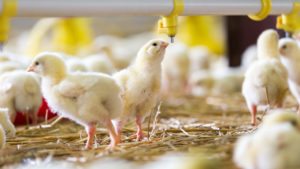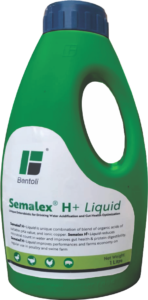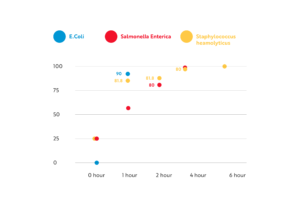Water is the most important nutrient for the overall health and performance of birds.Water intake of poultry is approximately twice that of the intake of feeds. During its lifetime, a five-pound broiler will consume about 18 pounds of water, compared to approximately 10 pounds of feed (Lacy, 2002). A key factor that determines the wholesomeness of water is its microbial quality. Water is presumed safe if it has a zero microbial population.The drinking water plays an important role in the transmission of some bacterial, viral and protozoan diseases like Colibacillosis, Fowl Typhoid, Avian Cholera, Newcastle Disease, Infectious bronchitis, Mareks disease and Coccidiosis etc. To reduce water borne disease challenges, in animal husbandry practices, acidification of drinking water is the modern cost effective approach. Organic acids, even when used as a chemical preservative, are Generally Recognized As Safe (GRAS) substances.
Short chain and medium chain fatty acid (C1-C7) and their salts have been used for a long time because they prevent growth of microbes, molds and formation of mycotoxins (Luckstadt, 2005).Van Immerseel et al., (2006) as stated medium chain fatty acids (C6 to C12; caproic, caprylic, capric and lauric acids) appear to be effective against Salmonella than short-chain fatty acids (C≤4; formic, acetic, propionic and butyric acids). The antimicrobial effect of an acid depends upon the dissociation constant (pKa) or pH, at which 50% of the total acid is undissociated.
Organic spectrum:
How does water acidifier work?
Water acidifier offers dual action while we talk about mode of action. Undissociated forms of organic acids, especially short-chain fatty acids like formic acid, lactic acid can freely diffuse through the semipermeable membrane of the bacteria into the cell cytoplasm. (Van Immerseel et al., 2006)
.
Inside the cell at pH 7, the acid dissociates and suppresses bacterial cell enzymes and nutrient transport systems ( Huyghebaert et al., 2011). Cationic part of the organic acid inhibits the DNA replication of the bacteria. Thereby it inhibits cell multiplication.
Water acidifiers work beyond water sanitation!
The short chain fatty acids present in water acidifiers are believed to increase plasma glucagon-like peptide 2 (GLP-2) and ileal pro-glucagon mRNA, glucose transporter (GLUT2) expression and protein expression, which are all signals which can potentially mediate gut epithelial cell proliferation. (Fukunaga et al., 2003).
Short chain fatty acids in water acidifiers support in improvement of digestibility of protein and ensure higher absorption rate of Ca, P,Mg, Zn which served as substrate in the intermediary metabolism (Veeramani et al.,2003). Pirgozliev et al. (2008) reported that there was significant (p<0.05) reduction of total viable coliform numbers in the ileum and caecum of broiler chicken while organic acid blends as water acidifiers are in regular use.
Oligodynamics- the newer approach to reinforce water acidification !
Oligodynamic is the ability of minerals to exert a lethal effect on bacterial cells. Oligodynamic metals, such as copper and silver, have long been used as sanitizers for non-spore-forming bacteria and viruses (Thurman & Gerba 1988).Copper has been used as a biocide for centuries (Dollwet et al., 2001).
Water acidifiers, while powered by ionic copper, offer a broad spectrum of effects on water borne infectants. The best part of the oligodynamic mechanism is the broader spectrum of coverage whether it is gram positive and gram negative as well.
Bentoli’s innovative solution, Semalex® H+ liquid is a unique enterobiotic for drinking water acidification and gut health optimization. It is a superior combination of short chain fatty acids, and ionic copper offering water acidification and gut eubiosis.
Recently a kinetic study was conducted in Bentoli’s research facility that proved the effect of a water acidifier (Semalex® H+ Liquid), against Staphylococcus haemolyticus, Escherichia coli and Salmonella enterica subsp. Indica. It was evaluated for 72 hrs where 0.0002% inoculum of the bacterial culture was treated with Semalex H+ Liquid at 200 and 500 ppm and the inhibition of the pathogens was studied. Results showed that Semalex® H+ Liquid completely inhibited Staphylococcus haemolyticus, Escherichia coli and Salmonella enterica subsp. indica between 2 to 6 hrs at 200 ppm.
References:
Dollwet HHA, Sorenson JRJ. Historic uses of copper compounds in medicine. Trace Elements Med 2001; 2: 80-7.
Fukunaga T M.; Y. Sasaki; T. Araki; T. Okamoto; T. Yasuoka; T. sujikawa; Y. Fujiyama and T. Bamba “Effects of the soluble fiber pectin on intestinal cell proliferation, fecal short chain fatty acid production and microbial population”. Digestion 67: 42-49, 2003
Hambidge, A., 2001. Reviewing efficacy of alternative water treatment techniques. Health estate, 55(6), pp.23-25.
Lacy M. P. Broiler management. In : Commercial Chicken Meat and Egg Production (D.B. Bell and W.D. Weaver, Eds.) 5th Ed. 2002. P. 829–868.
Luckstadt, C. “Synergistic acidifiers to fight Salmonella”, Feed Mix, 13,1, 28-30., 2005.
PESTI, G.M. and BAKALLI, R.I., 1996. Studies on the feeding of cupric sulfate pentahydrate and cupric citrate to broiler chickens. Poultry Science, 75(9), pp.1086-1091.
Thurman, R.B., Gerba, C.P. and Bitton, G., 1989. The molecular mechanisms of copper and silver ion disinfection of bacteria and viruses. Critical reviews in environmental science and technology, 18(4), pp.295-315.
Van Immerseel, L.; De Zutter; K. Houf; F. Pasmans; F. Haesebrouck and R. Ducatelle. “Strategies to control Salmonella in the broiler production chain.” World’s Poult. Sci. J. 65:367-392, 2009.
Veeramani, P.; S.T. Selvan and K. Viswanathan, Effect of acidic and alkaline drinking water on body weight gain and feed efficiency in commercial broiler. Int. J. Poult. Sci., 38: 42-44,,2003






